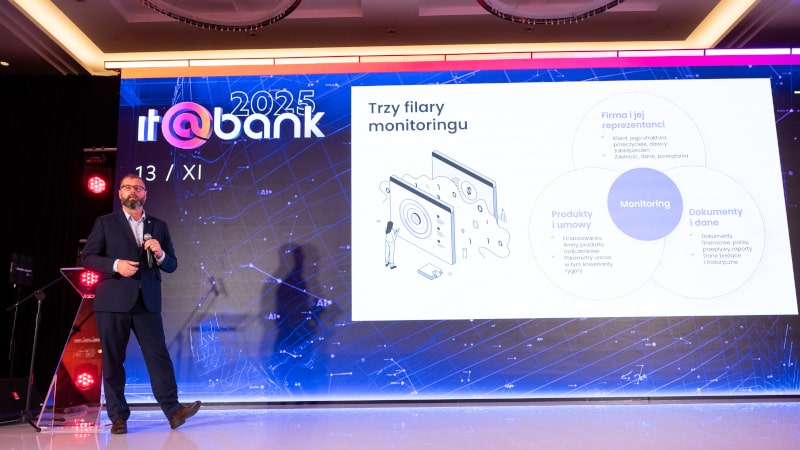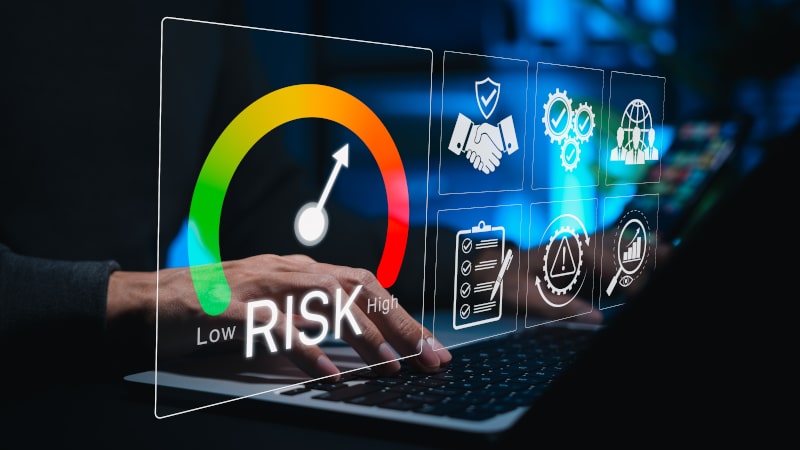Article prepared for Miesięcznik Finansowy Bank 11/2025
Many financial institutions still assess corporate credit risk in a point-in-time manner: during loan applications, selected operational activities, and periodic reviews. Today, that’s no longer enough. The economy moves faster than reporting cycles, and a single external shock can trigger a domino effect. Banks need to know what is happening with a client right now — not only when delays finally appear.
That’s why risk assessment tools can’t rely solely on historical data. They must reflect real-time conditions and — where needed — be tailored to the specifics of each client relationship. Building such tools and continuously optimizing them has become one of the key directions in corporate banking development.
The Challenges Facing Modern Financial Institutions
In many organizations, corporate client monitoring is still carried out manually. The most time-consuming tasks include document verification, covenant checks, and initiating remedial actions. The result? Teams work on dispersed data and risk reacting too late to early signs of deterioration.
Financial information sits in one system, collateral data in another, and market signals — if gathered at all — rarely make it into rating assessments on time. Reviews are often based on data that may already be weeks or months old, meaning the bank can be caught off guard at the exact moment when an early reaction would have made the biggest difference. Even the strongest analytical models struggle to keep pace with changing conditions and updated forecasts for client cooperation.
What’s also missing is a holistic view of the client — not just as a single entity but as part of a capital group and a broader network of connections. This complicates exposure assessment and delays corrective actions — a common pattern we see across many projects.
A “Living” Process, Not a Periodic One
In this environment, ratings and collateral monitoring cannot be occasional tasks. Risk assessment needs to evolve together with the client and indicate when the situation begins to raise concerns. The system should automatically notify relevant teams about emerging threats and suggest actions that can mitigate risk before it turns into a cost.
Such automation enables institutions to act proactively — before issues become real losses or before collateral turns out insufficient. It’s a radar showing where the portfolio requires more attention, which relationships should develop with increased responsibility, and which clients can confidently become the focus of CRM initiatives.
A Central Risk Repository as the Backbone of Digitalization
To respond quickly to changes in client situations, banks need more than good scoring models. They need reliable, up-to-date data in one place. This is why a central risk repository (VSoft Rating) becomes the foundation of monitoring transformation. It’s not just another database — it’s the central nervous system of the entire risk-decision process.
The repository consolidates all client information: financials, CRM data, transactions, capital links, collateral and its value, as well as market signals. Analysts no longer have to assemble the full picture from fragmented sources — they get it ready, structured, and complete.
This allows the bank to assess exposure not only at the transaction level but across the entire relationship — including the capital group context. Rating updates or parameter changes happen automatically, triggered by the system. Analysts reclaim time to focus on what truly matters: interpretation, recommendations, and growing safe business.
Such a repository influences the entire organization. It unifies data across local units and headquarters, clarifies accountability, and introduces standardized workflows. As a result, monitoring becomes more scalable and resilient to organizational changes — and the bank can operate swiftly and confidently, whether it serves a few hundred or tens of thousands of corporate clients.
Technologies That Strengthen the Process
Automating monitoring isn’t about digitizing existing tasks — it’s about shifting the risk mindset from reactive to proactive. This shift is clearly visible in the projects we implement with banks.
The foundation is a strong business and technical concept. Next comes continuous data processing. The system pulls information from financial reports and external sources, tracks changes in ownership structures and regulations, and logs signals related to collateral or transactions. Any change affecting risk can automatically trigger a system reaction: an alert, a rating update, or the initiation of a review process.
Another crucial layer is data integration — because even the best models won’t show the full client picture without it. Only by combining information from core systems, CRM platforms, and external trade and industry databases can a bank operate based on facts rather than assumptions.
And finally — technological agility. In environments where organizational or regulatory structures change dynamically, systems can be developed using low-code solutions (like VSoft archITekt), AI-based tools for document assessment, collateral analysis, or fraud verification. This shortens implementation time and enables banks to react faster to market shifts and supervisory expectations — without engaging large project teams.
The results we observe with clients confirm the impact: risk stops catching banks off guard, and decisions are made not “too late,” but exactly when they can still influence the relationship. That is what differentiates stable institutions from those that only respond after issues materialize.
Measurable Benefits
Transforming the monitoring process significantly strengthens the bank’s financial security. Continuous, automated client assessment shortens response time to warning signs and reduces credit losses while improving portfolio quality. Banks can scale operations without proportional increases in operating costs, and unified processes with clear audit trails make it easier to meet regulatory requirements.
Importantly, monitoring does not limit commercial activities — on the contrary, it enables more conscious, controlled growth of exposure and strengthens long-term partnerships with business clients.
Conclusion: An Investment in Safety and Growth
Effective corporate monitoring has become a strategic asset — shaping portfolio quality, risk costs, and a bank’s market advantage. To work well, it must be rooted in an understanding of processes, not just technology implementation. Combining analytical expertise, implementation experience, and modern tools enables safe and sustainable growth.
This is the foundation we build together with banks — and we can clearly see how much it contributes to their resilience and long-term development.




